JOHN S. ALLEN'S BICYCLE FACILITIES, LAWS AND PROGRAMS PAGES |
||
 |
Top: Home Page Up: Minneapolis Previous:11th Street S. Next: 4th Street S. |
 |
JOHN S. ALLEN'S BICYCLE FACILITIES, LAWS AND PROGRAMS PAGES |
||
 |
Top: Home Page Up: Minneapolis Previous:11th Street S. Next: 4th Street S. |
 |
Minneapolis bike lanes --
|
Hennepin Avenue
just west of 10th Street
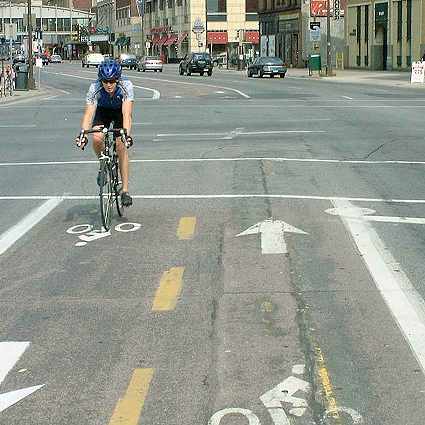
| Most but not all cyclists use the bike lanes. The two cyclists in the photo below, riding in the normal position on the roadway, are members of the City of Minneapolis police bicycle patrol. I also chose to ride in the normal position except when I went to the center of the street for the purpose of taking pictures. |
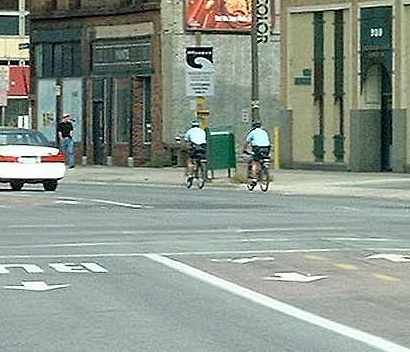
| There are advanced stop lines at some cross streets, as shown below. The space ahead of the advanced stop line is too short to serve as a "bike box", and so it is probable that the intention is to place a cyclist waiting for the traffic signal ahead of a motorist who is about to turn left, rather than for the cyclist to be able to swerve right in front of the motorist before merging to the right. However, a cyclist who arrives after the light has turned green is not protected by this arrangement in either case, as there is no separate signal phase for the cyclists. (see page about advanced stop lines). The cyclist's best defense is to remain behind the first vehicle waiting at an intersection, or to merge into the stream of motor traffic if the traffic is already moving. To avoid cyclists who move forward in the bike lane, a motorist preparing to turn left across the bike lane must look back to the left in order to avoid a cyclist in the bike lane, and at the same time scan the forward arc of vigilance for other vehicular and pedestrian traffic. The standard destination positioning at intersections avoids this difficulty. The motorist waiting to turn left in the image below apparently does not understand the intent of the advanced stop line. |
Motorist waiting to turn left from Hennepin Avenue onto 9th Street
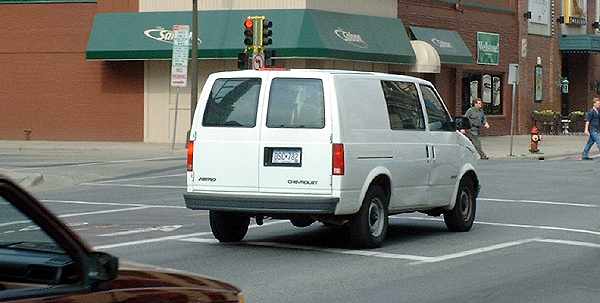
| In the sequence of photos below, a FedEx truck yields to a cyclist coming from the
opposite direction. Because the bikeway in Hennepin Avenue is a two-way bikeway, the
cyclist is somewhat farther away from the line of left-turning motor traffic in front of
him than a cyclist in the lane on Marquette Avenue or in any
contraflow bike lane adjacent to an opposite-direction travel lane. The green arrows in the last two photographs are to help you locate the cyclist. In the third photo, he has already entered the intersection -- his head is just visible over the top of a car. Also in the third photo, the driver of the van behind the Fed-Ex truck is lagging far enough behind to see the cyclist despite the height of the Fed-Ex truck. It is entirely possible that a driver following more closely would not see the bicyclist in time to yield when making a left turn. Good road design should, to the degree it is practical, avoid creating situations in which drivers must account for other drivers or pedestrians they can not see. That principle is violated by placing the bike lane in the middle of the roadway. |
Left-turn encounter on Hennepin Avenue
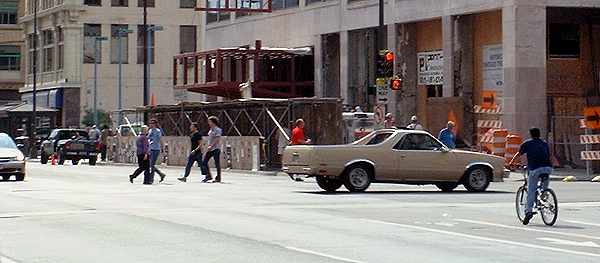
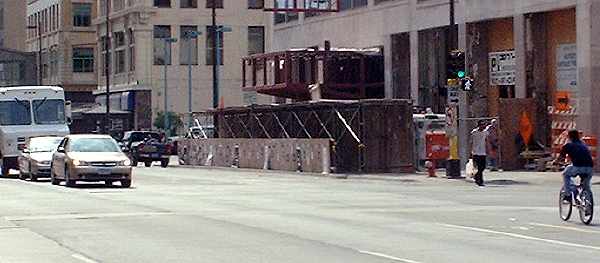
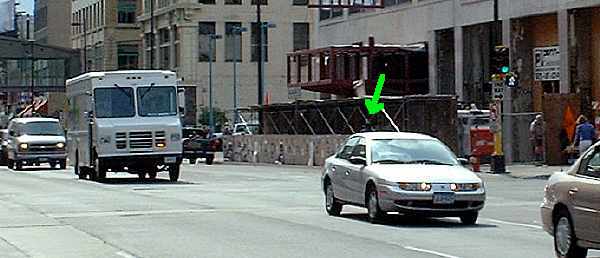
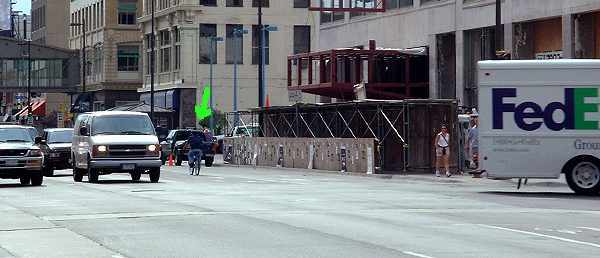
| At Washington Avenue, the two-way bike lane becomes one-way southbound. It leaves
northbound cyclists in the middle of the street with no normal way to continue. Returning
to the normal position on the right side of the roadway would require merging across three
travel lanes. The one-way bike lane southbound continues for one block, to First Street. Here, as everywhere else along the center bike lanes, cyclists must merge across lanes of traffic to enter (or exit) the bikeway, or else must cross to and from the center of the street as pedestrians. At all of the cross streets, traffic turns left across the bike lane, but at Washington Avenue, it includes city buses. When I took the photo below, I zoomed my camera's lens to telephoto, and I kept well back from the intersection to avoid the risk of being run over by the bus. |
Conflict with turning bus at Washington Avenue

Photo taken a couple of seconds later to show right lanes.
Northbound cyclists must cross three travel lanes
to return to the right side of the roadway.
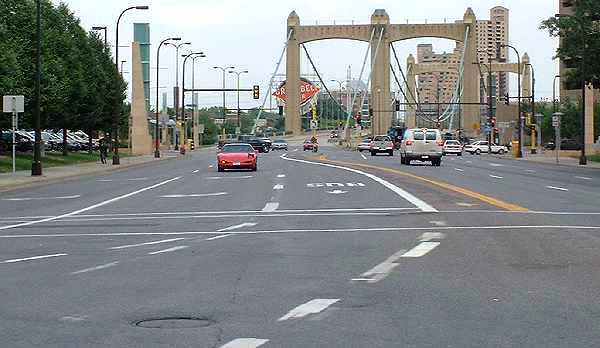
| A sign at the right side of the street, three travel lanes to the right of the bike lane, indicates the end of the bike lane, highlighting yet another problem with a center bikeway: the difficulty of placing signs. The right-hand travel lane here is of ample width for bicycle/motor vehicle lane sharing, as it is through most of Hennepin Avenue; It would be so everywhere if not for the center bikeway. As is common in Minneapolis, the bituminous concrete pavement adjoins wide, concrete gutter pans. The pavement is in good condition here, but as it wears, it will become uneven, and hazardous for bicyclists, at the joint with the gutter pan. |
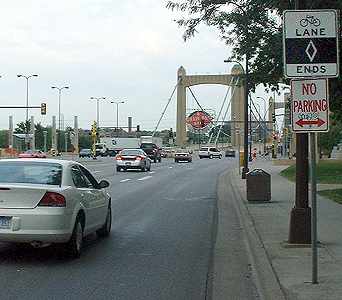
| Cyclists take various routes where the bike lane discontinues in the middle of the street. One cyclist continued on the left sidewalk, which leads to a sidewalk on the bridge ahead. |
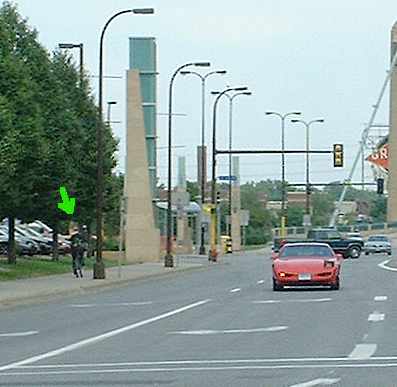
| The photo sequence below shows three nortbound cyclists crossing Washington Avenue. All three continue traveling opposite the intended direction of traffic in the center bike lane. (They all keep somewhat to the right of the lane in the photos, because I am occupying that lane as I stand over my bicycle taking pictures.) Two of the three cyclists enter the intersection at the same time as vehicles which might turn left. In the background of the third photo, a vehicle is shown turning left across the bikeway. And, in the last photo, a bus turns across the bikeway. |
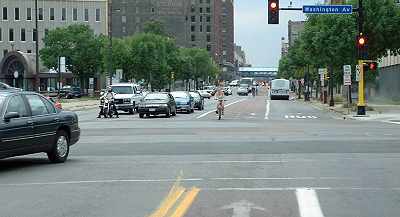 |
 |
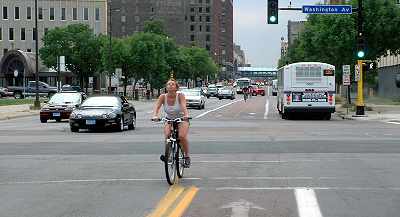 |
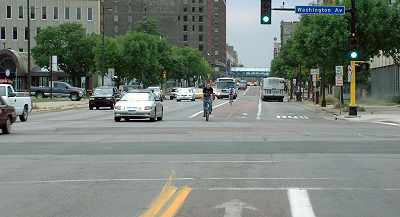 |
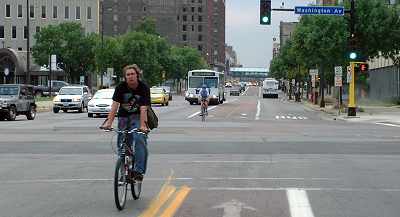 |
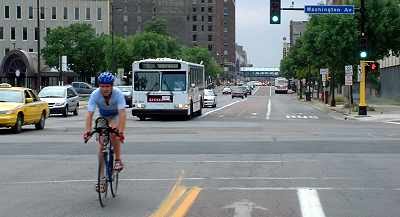 |
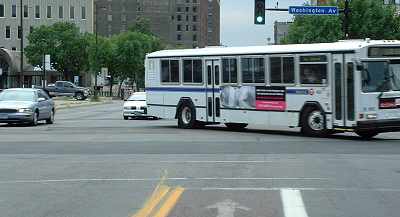 |
| Top: Home Page Up: Minneapolis Previous:11th Street S. Next: 4th Street S. |
Contents © 2003, John S. Allen |